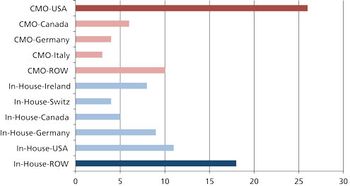
The agency is offering patients with life-threatening diseases a how-to tool on accessing investigational drugs.

The agency is offering patients with life-threatening diseases a how-to tool on accessing investigational drugs.

The agency announced a plan to eliminate its existing orphan designation request backlog.

Approval of breakthrough therapies requires expedited quality assessment.

CBER is moving forward with the development and approval of regenerative medicine advanced therapies.

Sandoz, a Novartis division, announced that the Committee for Medicinal Products for Human Use (CHMP) has adopted positive opinions recommending the approval of its biosimilars rituximab and etanercept in Europe, for the same indications as the respective reference medicines.

The agency approved Renflexis, a biosimilar to Janssen’s blockbuster rheumatoid arthritis treatment.

Pharmaceutical Technology spoke with CPhI North America presenter Jonathan Helfgott to discuss navigating GDUFA and helpful tips for submitting successful ANDAs.

The mAb is the first approved treatment that targets the progressive form of the disease.

Will new generic drugs bring the cost of medicines down in the way policy makers hope?

In a FDAVoice blog post, CBER Director Peter Marks discusses the new designation for cell therapies that treat life-threatening diseases.

Moving global manufacturing operations may be more complicated than it appears.

In 2016, FDA approved 630 ANDAs and tentatively approved 183 ANDAs, the highest number to date, according to the report.

FDA granted inotuzumab ozogamicin priority review and accepted its BLA for filing.

The regulatory agency rejected the medication, citing various issues related to device use.

FDA approved Valeant’s brodalumab with a boxed warning for suicidal ideation.

Drug companies are pushing Congress to action on funding for FDA programs and staff to expedite drug reviews and approvals.

A new report from HBM Partners said FDA new molecular entity approvals have dropped to 19 in 2016 from 45 in 2015.

FDA’s Center for Drug Evaluation and Research (CDER) approved 22 new molecular entities (NMEs) in 2016, according to a January 4, 2016 release from the agency. Of the 22 NMEs, 12 were large-molecule therapeutics. Of CDER’s 45 novel drug approvals in 2015, 17 were considered large-molecule therapeutics (larger than 900 Daltons).In 2016, 11 of the 12 large-molecule drugs that were approved were biologics. This includes seven monoclonal antibodies (mAbs), one hormone, and three DNA-derived medications. The remaining large-molecule medication was a diagnostic agent.

The agency recommended nine drugs including treatments for diabetes, hepatitis B, and HIV.

What’s ahead for the healthcare and pharmaceutical industries?

NICE recommended eribulin for the treatment of patients with breast cancer, reversing its 2012 decision.

FDA leaders insist that the decision to approve Sarepta’s Exondys (eteplirsen) should not be considered a model for future development of orphan drugs.

The agency clarifies how FDA determines when a risk evaluation and mitigation strategy is necessary.

The agency provides a qualified context of use for the biomarker plasma fibrinogen.

Concerns have emerged that continued growth in the biosimilars market could be limited by mounting pressure to push down on prescription drug outlays.